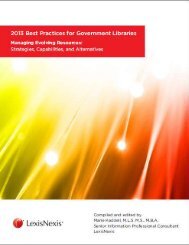2012 Best Practices for Government Libraries
2012 Best Practices for Government Libraries
2012 Best Practices for Government Libraries
You also want an ePaper? Increase the reach of your titles
YUMPU automatically turns print PDFs into web optimized ePapers that Google loves.
In<strong>for</strong>mation Collection and Exchange (ICE)<br />
79<br />
BEST PRACTICES <strong>2012</strong><br />
In<strong>for</strong>mation Collection and Exchange (ICE) produces the key publications used by posts<br />
during PST and other training events. Publications are available in print and PDF <strong>for</strong>mat.<br />
Typically, post staff members order from ICE the print publications they need <strong>for</strong> training<br />
events and to build their local In<strong>for</strong>mation Resource Center (IRC) collections. Volunteers<br />
may also request print publications directly from ICE. In FY2011, ICE distributed, upon<br />
request, over 35,000 print copies of 75 unique publication titles to staff and Volunteers at<br />
Peace Corps posts around the world.<br />
ICE also produces and distributes a CD-ROM with over 160 ICE publications in PDF <strong>for</strong>mat,<br />
including the 75 titles that are available in print. This CD-ROM is distributed to all<br />
Volunteer trainees during the initial PST period in-country. This ensures a captive<br />
audience and provides the best opportunity to reach all incoming Volunteers. ICE<br />
encourages posts to also distribute the publications in ways that work best <strong>for</strong> their<br />
country-specific situations. Some posts upload the publications to their internal websites<br />
or shared drives. Others include the publications on USB flash drives that they load with a<br />
variety of resources and distribute to their Volunteers. Currently, the CD-ROM is the most<br />
cost-effective way ICE has found to produce and disseminate the larger set of publications<br />
to all posts to distribute to Volunteers worldwide.<br />
Access to technology and <strong>for</strong>mat preferences<br />
Through an annual reporting process, ICE is able to ask posts several questions related to<br />
Volunteer access to technology and <strong>for</strong>mat preferences <strong>for</strong> publications. Of those posts<br />
responding, 42 percent estimate that 90 percent or more of Volunteers have access to the<br />
Internet at least once per week. However, there remains a significant number of<br />
Volunteers without weekly access to the Internet or a computer. Access to the Internet<br />
also varies significantly by region and post, with the Africa region featuring the lowest<br />
access rates. Access to a computer with a CD-ROM drive is complicated by changing<br />
technologies – as newer computers often allow <strong>for</strong> a USB drive but no longer include a<br />
CD-ROM drive.<br />
Although declining in popularity, print continues to be the most preferred <strong>for</strong>mat <strong>for</strong><br />
receiving ICE publications. Again, the responses vary considerably by region and post.<br />
Some posts indicate a preference <strong>for</strong> print because it is easier to share with others in the<br />
field, or because access to technology is expensive or unreliable, or because printing costs<br />
are prohibitively high. Other posts prefer digital <strong>for</strong>mats because of space, portability, or<br />
<strong>for</strong> environmental reasons. CD-ROMs are not compatible with newer devices and USB<br />
drives are increasingly preferred over CD-ROM. Some posts have indicated their<br />
preference <strong>for</strong> both print and digital <strong>for</strong>mat options <strong>for</strong> using ICE publications in different<br />
situations and at different times.<br />
Newer technologies and the future<br />
Volunteers and field staff, of course, need and also create and share other technical<br />
training in<strong>for</strong>mation and publications from a wide variety of sources. The methods are as<br />
varied as one might imagine <strong>for</strong> a decentralized organization operating worldwide.<br />
Volunteers and some posts use blogs, wikis, websites, YouTube, Twitter, Google Docs<br />
accounts, Facebook, and other vehicles to share in<strong>for</strong>mation. For various reasons, there is<br />
currently no single website or network space <strong>for</strong> sharing digital files across all of the Peace



